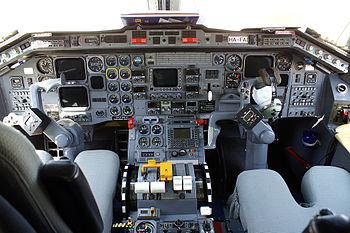flight mecanics: physical understanding
Sat 31 January 2015
 pilots' control (Photo credit: Wikipedia)
pilots' control (Photo credit: Wikipedia)
I think I must clarify how do a aircraft fly. First of all, not that an aircraft is a physical object on wich many forces apply. Those forces make it move and rotate. Some of this forces are easily controlable, other are controlable but not easily, and other are just constraints. All those forces work and energy budget must be consider.
forces overview
weight
[caption id="" align="alignright" width="75" class="zemanta-img"] gravity's illustration (Photo credit: Wikipedia)[/caption]
gravity's illustration (Photo credit: Wikipedia)[/caption]
This is due to gravitation, and porportional to the mass of the airplane. Note that the frame of reference to consider when speaking of this force is relative to earth.
aerodynamic force
This force is usualy decomposed into drag and lift. As a first approximation, the lift is the component directed above the airplane, the drag is the rest. The frame of reference implicilty linked to this force is relative to the airmass the airplane is evolving in. The only condition in which this frame of reference is equivalent to the one used for weight is when there is zero wind, i.e. no movement of the airmass relative to the earth (horizontally and vertically).
engines necessity
If you have only those 2 forces (gravity and aerodynamic), you have a glider. A glider must descend to balance thoses forces (as any skidiver once it has reached its maximal velocity). As diving is hardly flying, you must find a way to maintain or gain alitude. This is done thanks to an engine (or a moving airmass). The engine produce a force oriented forward[1. this is a really good approximation, some asymmetry may exist because of torque, propwash, and other side-effects]. The frame of reference used to define this force is relative to the airplane. The relation with the frame of reference relative to earth is linked with pitch and yaw.
energy overview
The most important thing to understand is energy. Each force and energy are linked throught work. Be careful weather this energy is negative or positive. Here, we consider the following energies:
- mechanical: like a roller coaster, the airplane is a vehicle evolving within a certain speed range and altitude range
- potential due to earth gravity: directly linked to the altitude ([latex]E_p=m g h[/latex] with[latex]m[/latex] the airplane mass, [latex]g[/latex] the gravitational acceleration, and [latex]h[/latex] the altitude of the airplane)
- kinetic ( [latex]E_k = 1/2 m v^2 [/latex] with[latex]m[/latex] as above, and [latex]v[/latex] the speed of the airplane relative to earth)
- chemical inside fuel tank and easily converted in mechanical energy
- aerodynamic due to aerodynamic forces. This is linked to aerodynamic forces, and this is the way to put energy away from the airplane
All the flight consist in transforming one type of energy to another. Note that the engine's role is only to tranform chemical energy into mechanical energy, i.e. adding potential and/or kinetic energy to the airplane.
controlability
An airplane is a big object. Thus we must also consider torque. Most of controlability of the airplane is made through local modification of aerodynamic forces. This is done by moving control surface that locally modify airflow and thus aerodynamic force. This cause torque and rapid modification of overall aerodynamic force.
Another way to control the airplane attitude is to change other forces. This is a really less reactive manner to control the airplane. This is done by changing the trhust delivered by the engines, and moving the center of gravity and the mass of the airplane. This can be done by displacing passengers, consuming fuel, droping skydivers, hitting big flies that stay glued to the airplane,...
Category: aviation Tagged: Fixed-wing aircraft Flight control surface